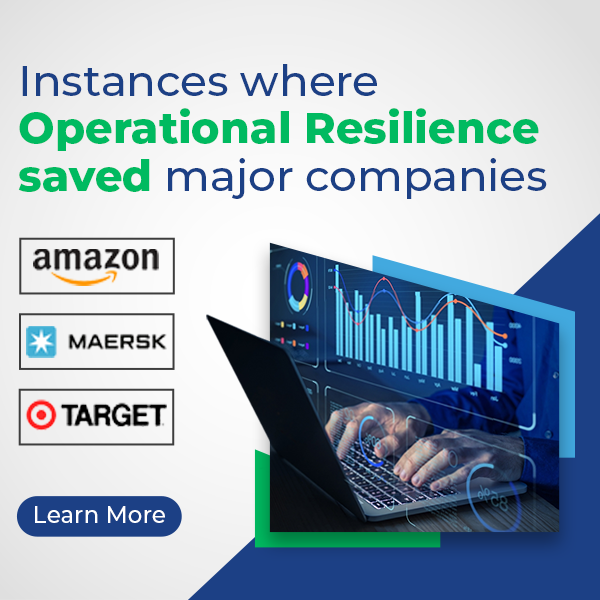In today’s ever-changing business world, Operational Resilience helps organizations tackle unforeseen challenges. Operational resilience stands as a beacon of strength, enabling companies to work with agility and emerge stronger. In the following article, several instances have been shared where different companies have been saved because of operational resilience. It will showcase how proactive strategies and robust frameworks have not only averted crises but also propelled organizations toward sustained success in the face of adversity.
Amazon in 2020 (Pandemic Resilience):
In 2020, the COVID-19 pandemic brought about immense challenges for businesses across the globe. Despite this, Amazon, a company recognized for its operational prowess, showed remarkable strength during this crisis. Amazon had put substantial resources into making its supply chain flexible, incorporating automation, and building a robust cloud computing infrastructure.
When the demand for online shopping skyrocketed and disruptions hit their supply chain, Amazon didn’t falter. They acted quickly by hiring more workers, putting safety measures in place, and leveraging their technological capabilities to meet the surging demand for online shopping and cloud services. Thanks to Amazon’s ability to adapt and its operational resilience, the company not only weathered the challenges of the pandemic but actually thrived. This was in stark contrast to many other businesses that faced significant difficulties or had to close their doors.
Amazon’s Pandemic Response: Key Steps Taken
In the face of COVID-19 challenges, Amazon did not just survive; it thrived by fortifying its operations in key ways. They invested a lot in technology and automation for their supply chain, making it flexible and adaptable to sudden changes.
To minimize risks, they diversified their supplier network, reducing dependence on specific regions. Recognizing the surge in online shopping, they quickly hired more people and ensured their safety through comprehensive protocols.
Amazon’s reliance on Amazon Web Services (AWS), their cloud platform, played a crucial role in handling the increased demand for online services. They also adapted their technology to support remote work during lockdowns. Communication with customers remained transparent, managing expectations about potential delays. They kept essential services running smoothly, including their e-commerce platform and logistics operations.
Diversifying their business lines, such as e-commerce, cloud services, and streaming, helped balance the impacts of the crisis. Amazon’s ability to make agile decisions and plan for different scenarios showcased their proactive approach.
The result?
Amazon emerged not just intact, but stronger and more resilient than ever.
Walmart in 2005 (Natural Disaster Resilience):
Back in 2005, Hurricane Katrina wreaked havoc on the Gulf Coast, leaving widespread destruction in its wake. In the midst of this crisis, Walmart, the retail giant, stood out for its smart preparations. They had put a ton of effort and resources into being ready for emergencies—things like disaster recovery plans and backup supply chains. When the Hurricane hit, Walmart was quick on its feet. They assessed the damage quickly, moved goods and people to the areas that needed them, and kept their stores running to serve the communities.
While many businesses were struggling to get back on their feet, Walmart’s clever planning meant they could keep going. They didn’t just stop at that; they even pitched in with essential supplies for the areas hit hardest. This whole experience earned them a reputation for being a company you could count on, one that could handle tough situations and come out even more robust.
In the 2005 Hurricane Katrina crisis, Walmart implemented robust operational resilience strategies. Their proactive disaster recovery planning, including investment in preparedness, set the stage for a swift and effective response. With a diversified supplier network and backup distribution centers, Walmart ensured the flexibility and redundancy of its supply chain.
Rapid impact assessment allowed them to gauge the extent of damage quickly. The company’s commitment to operational resilience became evident through the efficient redistribution of inventory and personnel, maintenance store operations in affected areas.
Walmart not only continued serving customers but also played a pivotal role in disaster relief by providing essential supplies to affected communities. Clear communication and coordination with authorities showcased the importance of collaboration in crisis management. This comprehensive approach not only helped Walmart weather the storm but also solidified its reputation as a reliable and responsible corporate entity.
Maersk in 2017 (Cybersecurity Resilience):
This sizable international shipping company, Maersk, suffered significantly in 2017 as a result of the NotPetya cyberattack. It messed up their computer systems big time, causing chaos in their worldwide operations. Now, here’s the cool part—Maersk didn’t crumble. Thanks to their smart planning, they had these robust backup and disaster recovery systems in place. So, even though everything went haywire, they managed to get their critical computer stuff back up and running pretty fast.
Maersk had invested a bunch in keeping their digital world secure. They had these cybersecurity measures that proved super useful. Plus, they had this well-thought-out plan for when bad things like this happen—it’s called an incident response plan. Following that plan helped them handle the attack like pros. They didn’t just bounce back; they did it relatively quickly. This whole deal showed how being ready for cyber threats is crucial, and Maersk’s smart moves demonstrated the power of being resilient in the face of digital trouble.
Maersk’s Cyber Attack Response: Key Steps Taken
When Maersk got hit with the NotPetya ransomware attack, their game plan for tough situations turned out to be the hero. They were smart about it—they had these backup systems that could bounce back their critical computer stuff super quickly. They weren’t just relying on luck; they had thought ahead. Maersk was serious about keeping their digital world safe, doing things like regular security check-ups and making sure everyone knew how to spot and handle cyber threats.
But here’s the cool part—they had this playbook, like a step-by-step guide, for when things went south. It helped them stay organized and get things back on track. They weren’t doing it alone either; they teamed up with cybersecurity experts and did these practice runs to stay sharp.
After the attack, they didn’t just dust themselves off and move on. Maersk took a good, hard look at what went down, figuring out how to do things even better next time. This whole approach showed that being ready, investing in the right tech, and being able to roll with the punches is key when it comes to dealing with tricky stuff like cyber threats.
Conclusion
In the fast-paced world of business, facing the unexpected is the name of the game. Operational resilience isn’t just a concept; it’s the superhero cape that companies wear to triumph over challenges. The stories of Amazon thriving in the pandemic, Walmart standing strong during Hurricane Katrina, and Maersk bouncing back from a cyberattack reveal the real-life power of being prepared. It’s not about avoiding storms but dancing in the rain with flexibility and strength. These tales underscore that operational resilience is the secret sauce—a blend of smart planning, adaptability, and a dash of innovation—ensuring companies not only survive but emerge victorious in the ever-evolving business landscape.
Is your organization ready to face unexpected challenges like these?
Discover our resilience management platform, “AutoResilience”, an industry-leading platform recognized by analysts like Gartner and Forrester. Autoresilience has four pillars: risk, crisis, business continuity, and cyber resilience.
Not only have we helped numerous banks globally reduce the impact of disruptions, but we have also ensured regulatory compliance and safeguarded their reputations.
Risk should no longer be feared or avoided but instead utilized as a means to achieve strategic value and improve performance.
“Businesses often face situations involving various types of obstacles that impact their operations, so they need to have a strong risk management strategy in place.”













